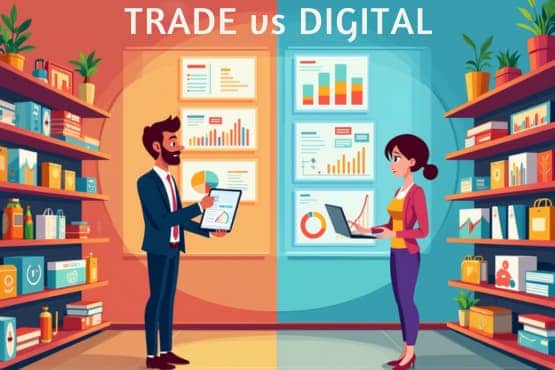With digital technology, Businesses have changed how they market themselves. These changes have changed how businesses connect with customers and business partners. Companies must manage two key but related strategies to be competitive: trade marketing and digital marketing.
A recent Nielsen study found that businesses that combine trade and digital marketing see, on average, a 27% increase in ROI compared to those with separate, siloed approaches (Nielsen, 2023).
Of course, the right balance of trade and digital marketing will vary depending on your business size and shape. Large corporates with extensive retail networks tend to lean more on trade marketing.
At the same time, small to medium-sized businesses (SMEs) and direct-to-consumer (D2C) brands will find digital more accessible and affordable. In this article, we’ll look at how different businesses can see what works for them.
Key Takeaways:
- Trade marketing focuses on B2B relationships, while digital marketing targets end consumers.
- Both strategies are crucial in today’s omnichannel retail environment
- Integration of trade and digital marketing can lead to significant performance improvements
- Understanding the strengths of each approach helps businesses create more effective marketing strategies
What is Trade Marketing?
Trade marketing is a B2B marketing strategy that aims to increase product demand at the wholesaler, distributor, or retailer level rather than at the consumer level.
Its primary goal is to create strong partnerships within the supply chain to ensure products are well-positioned and promoted effectively in retail environments.

Evolution of Trade Marketing
Traditionally, trade marketing involved in-store promotions, product displays, and negotiations with retailers for prime shelf space.
However, as e-commerce has grown, trade marketing has evolved to include digital elements. For instance, many brands now optimise their digital shelf space on online marketplaces and retailer websites.
Characteristics of Modern Trade Marketing
- Focus on B2B relationships
- Emphasis on product placement and visibility
- Integration of in-store and online strategies
- Use of trade promotions and discounts
- Collaboration with retailers on marketing initiatives
What is Digital Marketing?
Digital marketing encompasses all marketing efforts that use electronic devices or the internet to connect with current and prospective customers.
This broad field includes various strategies and tactics to engage consumers through digital channels.
B2C vs B2B Digital Marketing
While digital marketing is often associated with B2C strategies, it’s equally important in B2B contexts.
B2C digital marketing typically focuses on direct consumer engagement, while B2B digital marketing emphasizes lead generation and relationship building with other businesses.

Characteristics of Digital Marketing
- Multi-channel approach (social media, email, SEO, content marketing, etc.)
- Data-driven decision making
- Personalization and targeting capabilities
- Real-time campaign optimization
- Focus on measurable ROI
Differences Between Trade Marketing and Digital Marketing
Focus and Objectives
| Trade Marketing | Digital Marketing |
|---|---|
| Target businesses within the supply chain | Focuses on engaging end consumers directly |
| Aims to secure better product placement | Builds brand awareness and drives website traffic |
| Increases distribution | Generates leads and directs sales |
| Drives sell-through at the retail level | Increases online conversions |
Channels and Tactics
Trade marketing relies heavily on in-person interactions, trade shows, and retail partnerships. Common tactics include:
- Negotiating for prime shelf space
- Creating eye-catching in-store displays
- Offering volume discounts to retailers
- Collaborating on joint marketing campaigns with retail partners
Digital marketing utilizes a wide array of online channels and tactics, such as:
- Search engine optimization (SEO)
- Pay-per-click advertising (PPC)
- Social media marketing
- Email marketing campaigns
- Content marketing (blogs, videos, podcasts)

Technology Utilization
While both approaches increasingly leverage technology, their focus differs:
Trade marketing often uses:
- Customer Relationship Management (CRM) systems to manage retailer relationships
- Trade promotion management software
- Retail execution tools for field sales teams
Digital marketing relies heavily on the following:
- Marketing automation platforms
- Analytics and data visualization tools
- Ad tech platforms for programmatic advertising
- Social media management tools
Measurement and ROI
| Trade Marketing Metrics | Digital Marketing Metrics |
|---|---|
| Sales volume through specific retail channels | Website traffic and engagement rates |
| Market share growth | Conversion rates |
| Return on trade spend | Customer acquisition cost |
| In-store visibility metrics (e.g., share of shelf) | Lifetime customer value |
| Social media engagement and reach |
Pros and Cons
Trade Marketing Advantages
- Builds strong relationships with key retail partners
- Can significantly influence product placement and visibility
- Effective for industries with complex distribution channels
For example, Procter & Gamble’s robust trade marketing strategies have helped it secure prime shelf space and promotional opportunities with major retailers like Walmart and Target, contributing to its market leadership in many product categories.
Trade Marketing Disadvantages
- It can be resource-intensive and costly
- Limited direct interaction with end consumers
- Effectiveness can be challenging to measure precisely

Digital Marketing Advantages
- Offers precise targeting and personalization capabilities
- Provides rich data for analysis and optimization
- It can be more cost-effective, especially for small businesses
A case in point is Dollar Shave Club, which built a billion-dollar brand primarily through digital marketing, leveraging viral video content and targeted social media advertising to disrupt the razor industry.
Digital Marketing Disadvantages
- Highly competitive landscape
- Constantly evolving platforms and algorithms
- Potential for ad fatigue and banner blindness among consumers
Real-world Examples
Successful Trade Marketing Campaign
Coca-Cola’s “Share a Coke” campaign is a prime example of effective trade marketing integrated with digital elements.
The campaign involved customizing Coke bottle labels with popular names and phrases, which created a buzz among consumers and drove significant in-store visibility and sales.
Retailers were eager to stock and prominently display these customized products, leading to a 2.5% increase in total sales volume.
Effective Digital Marketing Strategy
Airbnb’s digital marketing approach showcases the power of content marketing and social media engagement.
Their “Live There” campaign used data-driven insights to create personalized content for different user segments across various digital channels.
This strategy resulted in over 14 million video views and a 14% increase in 30-day active users.
Integrating Trade and Digital Marketing
While trade and digital marketing have distinct focuses, successful companies often find ways to integrate both strategies for maximum impact.
Here’s how different industries approach this integration:

FMCG (Fast-Moving Consumer Goods)
FMCG companies like Unilever combine in-store promotions with targeted digital ads.
For example, they might use geofencing technology to send mobile notifications about in-store promotions to nearby consumers, bridging the gap between digital engagement and physical store visits.
Luxury Retail
Brands like Burberry use digital showrooms to enhance their trade marketing efforts.
These digital platforms allow retail buyers to explore collections virtually, complementing traditional trade show experiences with immersive digital interactions.
Technology Sector
Companies like Apple integrate trade and digital marketing by creating consistent brand experiences across online platforms and physical retail stores.
Their product launches typically involve coordinated efforts across digital channels, in-store displays, and retailer partnerships.
Step-by-Step Example: Integrating Trade and Digital Marketing
Let’s look at how a mid-sized consumer electronics brand might integrate trade and digital marketing for a new product launch:

- Pre-launch Trade Marketing:
- Negotiate prime shelf space with major electronics retailers.
- Create eye-catching in-store displays and train retail staff on product features.
- Digital Teaser Campaign:
- Run social media and display ads to build anticipation among target consumers.
- Create a landing page for early sign-ups and build a database for future marketing.
- Retailer-Specific Digital Campaigns:
- Collaborate with retail partners on co-branded digital ads.
- Offer exclusive online-only deals for each retail partner to drive online and in-store traffic.
- In-Store Digital Integration:
- Implement QR codes on in-store displays linking to product demo videos and customer reviews.
- Use beacon technology to send push notifications about the product to shoppers’ phones in-store.
- Post-Purchase Digital Engagement:
- Encourage product registration through a mobile app, offering extended warranty for sign-ups.
- Use email marketing to provide usage tips and cross-sell accessories.
- Data Sharing with Retail Partners:
- Share insights from digital campaigns with retailers to optimize in-store placement and promotions.
- Use retailer point-of-sale data to refine digital targeting for future campaigns.
- Continuous Optimization:
- Regularly analyze both in-store sales data and digital marketing metrics.
- Adjust the marketing mix based on performance, scaling successful strategies across channels.
This integrated approach allows the brand to leverage trade and digital marketing strengths, creating a seamless consumer experience while maximizing visibility and sales through retail partners.
Decision Matrix: Choosing Between Trade and Digital Marketing
Use this matrix to help determine which approach might be more suitable for your business:

| Factor | Trade Marketing | Digital Marketing |
|---|---|---|
| Primary audience | Retailers and distributors | End consumers |
| Budget size | Typically larger | It can be scaled for any budget |
| Sales cycle | Often longer | It can be shorter, especially for B2C |
| Product Type | Physical goods | Physical or digital products/services |
| Distribution model | Through retailers | Direct-to-consumer or through retailers |
| Measurement precision | Less precise | Highly measurable |
| Time to see results | Often slower | It can be quicker, especially for digital campaigns |
Future Trends
As the lines between physical and digital retail continue to blur, we can expect more significant integration of trade and digital marketing strategies. Some emerging trends include:

- Augmented Reality (AR) in retail spaces: Brands like IKEA use AR to enhance the in-store experience, bridging the gap between physical and digital shopping.
- AI-driven personalization: Both trade and digital marketers leverage AI to create more targeted and effective campaigns.
- Voice commerce: As smart speakers become more prevalent, trade and digital marketing strategies must adapt to voice-based search and shopping.
- Sustainability focus: Brands increasingly incorporate sustainability messages into their trade and digital marketing efforts, responding to growing consumer concerns about environmental impact.
When to Use Each Approach
The choice between trade and digital marketing often depends on your business model, industry, and specific goals. However, many successful companies use a combination of both:
Use trade marketing when:
- You’re launching a new product and need retailer buy-in
- You’re in an industry with solid retailer influence (e.g., grocery, consumer packaged goods)
- You want to improve your product’s in-store visibility and placement

Use digital marketing when:
- You’re targeting end consumers directly
- You’re a direct-to-consumer (D2C) brand
- You need to build brand awareness quickly
- You want highly measurable and scalable marketing efforts
Small Business Spotlight
As mentioned, small businesses often find digital marketing more accessible and cost-effective.
However, as they grow, incorporating elements of trade marketing can become increasingly valuable.

Here’s a quick guide for small businesses navigating the trade vs digital marketing landscape:
- Start with digital: Begin with a solid digital presence, as it’s often more cost-effective and scalable for smaller businesses.
- Leverage e-commerce platforms: Use platforms like Amazon or Shopify to gain visibility without heavy trade marketing investments.
- Build relationships: As you grow, develop relationships with local retailers or distributors to expand your reach, gradually introducing trade marketing tactics.
- Use data: Leverage digital marketing data to inform your trade marketing strategies as you expand.
- Scale gradually: As your business grows, incrementally increase your trade marketing efforts, using the strategies we discussed earlier for larger firms, but at a scale that fits your resources.
Remember, the key is to start with a solid digital foundation and gradually incorporate trade marketing elements as your business expands and your relationships with retailers and distributors grow.
Conclusion
Trade and digital marketing may seem like separate strategies, but the best businesses today find a way to merge them. Trade marketing, which focuses on B2B relationships and in-store presence, complements digital marketing’s focus on consumer engagement and data-driven decisions.
The lines are blurring as retail evolves – especially with the growing connection between e-commerce and physical stores. Businesses combining and using both strengths will have the edge in today’s fast-paced market.
By understanding trade marketing vs digital marketing differences, businesses can develop more well-rounded strategies that fuel growth across all channels.




